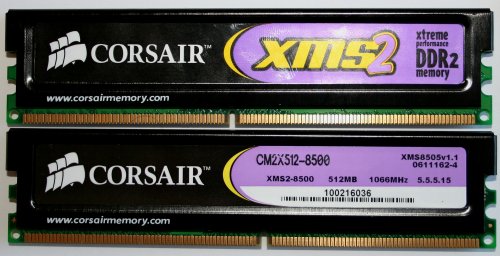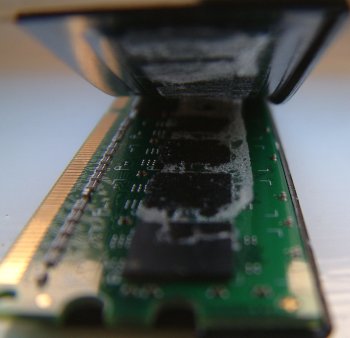Module examination and thoughts
A little backgroundIf we take Intel's top-of-the-range Pentium Extreme Edition 965 processor and i975X chipset as an example, the '965 CPU, at stock speed, runs off a 1066MHz FSB that's shared between its dual cores. The link between CPU and discrete memory controller hub (MCH), then, operates at around 8.5GB/s (1066MHz x 8 bytes) and it's up to the subsystem to provide the required bandwidth to the processor, via the SDRAMS and memory controller hub. A memory bus that comprises of dual 64-bit controllers is able to output the 8.5GB/s by using modules operating at an effective 533MHz, or ~DDR4200 in regular parlance.
So why the need for super-fast memory when two modules of DDR4200 will do the trick? The simple answer is that more bandwidth is always better because theoretical bandwidth utilisation, listed above, rarely matches what's actually supplied to the CPU. Theoretically, however, a single Corsair PC8500 module provides exactly the right level of bandwidth to satiate a Pentium Extreme Edition 965 processor. A dual-channel pack, such as the TWIN2X-8500, offers up a potential 17GB/s! Big numbers, huh?
Corsair TWIN2X1024-8500 DDR2

Corsair ships its modules in a package that all but eliminates possible failures attributed to transportation. The packaging states that it's a matched memory pair, which actually means that both modules have been tested on a selected number of motherboards to ensure that they will work perfectly. Given such a high clockspeed, Corsair tests this particular SKU on an ASUS P5WD2-E Premium i975X motherboard, which is capable of running PC8500 memory with a 1066MHz FSB CPU at stock speeds.

Corsair currently offers its flagship DDR2 memory in a 1GByte pack that comprises two 512MByte modules. A 2GByte pack is to follow soon. Corsair also recommends a 2.2V operating voltage, up 0.4V from run-of-the-mill DDR2, and by keeping its aluminium heatspreaders and not recommending any additional cooling it's clear that the resulting heat isn't an overriding issue. We verified the fact by running a 3-hour burn-in test in which the heatspreaders on the module, firmly affixed to the SDRAMs underneath, became warm but not hot to the touch. The high-ish 5-5-5-15 latencies are required to ensure reliable operation at PC8500 speeds. It's interesting to note that these modules supercede Corsair's TWIN2X-8000UL that run at PC8000 (1000MHz) with lower 5-4-4-9 timings.
Talking about ultra-high DDR2 frequencies, a PC8500 rating, when allied to 1066MHz CPU, allows for synchronous memory-to-CPU data transfers without having to impact upon performance by buffering clocks. As mentioned above, this TWIN2X set, run in dual-channel mode on a compliant motherboard that can set DDR2-1066 with a 1066MHz FSB CPU, offers up around 17GB/s of bandwidth; twice what the processor is able to use. Indeed, it will be interesting to see just how effective single-channel mode is when compared with the usual dual-channel.
How has it gone so high?
So what's Corsair's secret in releasing the fastest (mass produced) DDR2 to date?

Whilst the above photo only shows module abuse by yours truly and just how well the heatspreader is affixed to the SDRAMs underneath, Corsair uses the very best Micron D rev RAM, arranged in 64M x 8 SDRAMs which are placed on one side only. Careful screening and rigorous testing guarantees validation at PC8500 speeds. Corsair backs up the modules with its lifetime warranty that's applicable if you purchase the modules from a Corsair-authorised dealer. Supposed high-speed memory failure can be due to a number of other factors, usually BIOS-related, and Corsair has a new Tech Support Express procedure designed to offer the fastest support. Our readers' experience is that Corsair is amongst the best manufacturers for responding to and providing product support.
Official specifications
Corsair TWIN2X1024-8500
Features 2 x 512MByte matched 240-pin DDR2 DIMMs
100% tested on an ASUS P5WD2-E i975X motherboard
5-5-5-15-2T latencies (CAS Latency - RAS Precharge - RAS-to-CAS Delay - RAS Activate to Precharge - Command Rate)
SPD programmed at JEDEC standard of 800MHz at 5-5-5-15 2T
2.2V operating voltage
Some heady numbers there. Let's now see just how fast it is.









